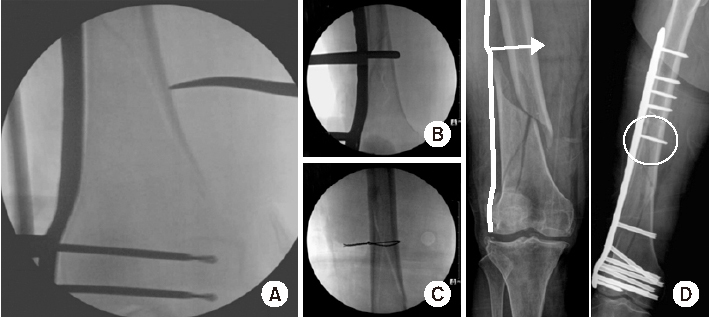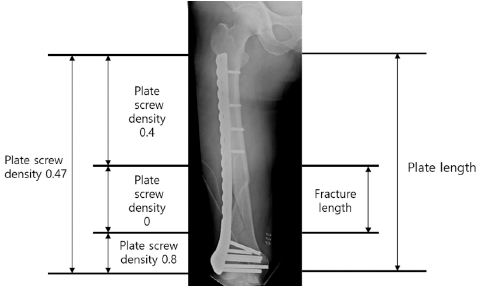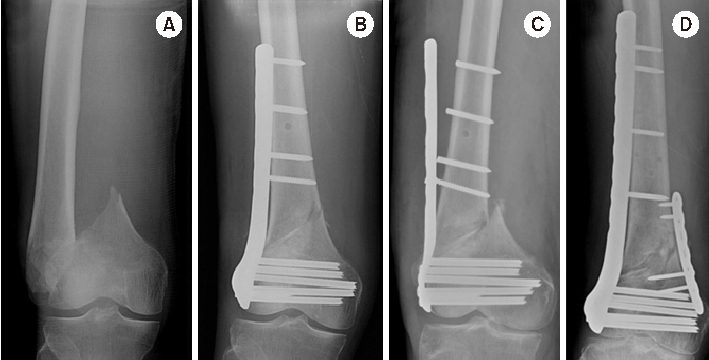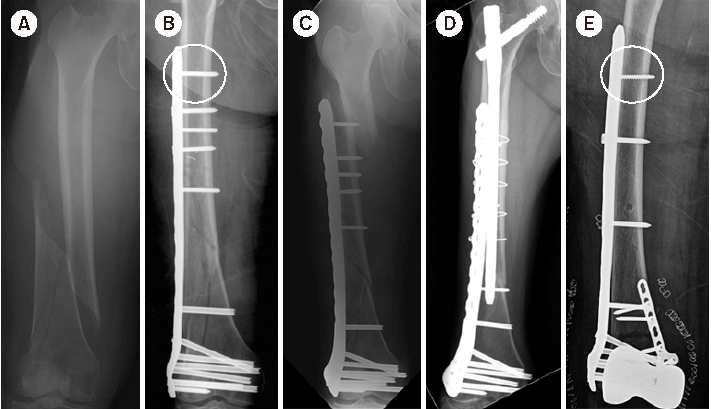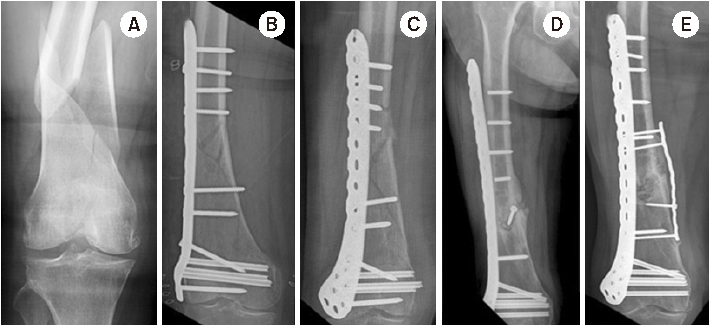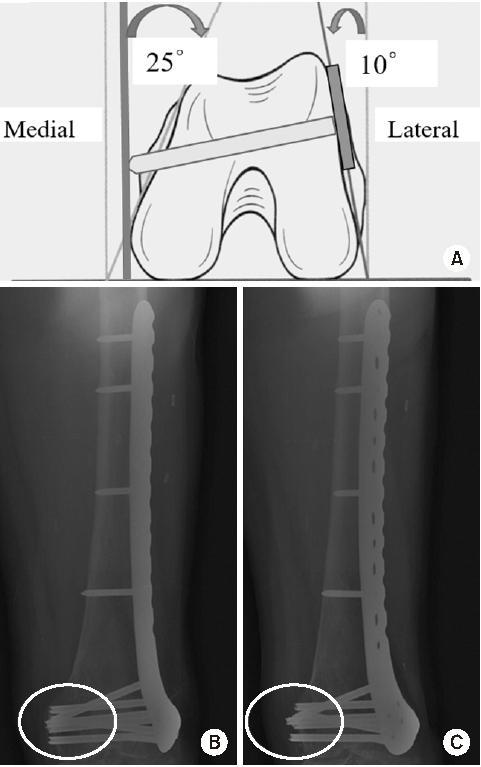References
1. Krettek C, Müller M, Miclau T. Evolution of minimally invasive plate osteosynthesis (MIPO) in the femur. Injury 2001;32Suppl 3. :SC14–SC23.
2. Stover M. Distal femoral fractures: current treatment, results and problems. Injury 2001;32Suppl 3. :SC3–SC13.
3. Wong MK, Leung F, Chow SP. Treatment of distal femoral fractures in the elderly using a less-invasive plating technique. Int Orthop 2005;29:117–120.
4. Mast J, Jakob R, Ganz R. Planning and reduction technique in fracture surgery Berlin, New York: Springer-Verlag; 1989.
5. Helfet DL, Shonnard PY, Levine D, Borrelli J Jr. Minimally invasive plate osteosynthesis of distal fractures of the tibia. Injury 1997;28Suppl 1. :A42–A47.
discussion A47-A48.
6. Kinast C, Bolhofner BR, Mast JW, Ganz R. Subtrochanteric fractures of the femur. Results of treatment with the 95 degrees condylar blade-plate. Clin Orthop Relat Res 1989;(238):122–130.
7. Krettek C, Schandelmaier P, Miclau T, Tscherne H. Minimally invasive percutaneous plate osteosynthesis (MIPPO) using the DCS in proximal and distal femoral fractures. Injury 1997;28Suppl 1. :A20–A30.
8. Wagner M. General principles for the clinical use of the LCP. Injury 2003;34Suppl 2. :B31–B42.
9. Goyal T, Nag HL, Tripathy SK. Dynamization of locked plating on distal femur fracture. Arch Orthop Trauma Surg 2011;131:1331–1332.
10. Fulkerson E, Egol KA, Kubiak EN, Liporace F, Kummer FJ, Koval KJ. Fixation of diaphyseal fractures with a segmental defect: a biomechanical comparison of locked and conventional plating techniques. J Trauma 2006;60:830–835.
11. Gardner MJ, Griffith MH, Demetrakopoulos D, et al. Hybrid locked plating of osteoporotic fractures of the humerus. J Bone Joint Surg Am 2006;88:1962–1967.
12. Greiwe RM, Archdeacon MT. Locking plate technology: current concepts. J Knee Surg 2007;20:50–55.
13. Lill H, Hepp P, Korner J, et al. Proximal humeral fractures: how stiff should an implant be? A comparative mechanical study with new implants in human specimens. Arch Orthop Trauma Surg 2003;123:74–81.
14. Stoffel K, Dieter U, Stachowiak G, Gächter A, Kuster MS. Bio mechanical testing of the LCP: how can stability in locked internal fixators be controlled? Injury 2003;34Suppl 2. :B11–B19.
15. Rozbruch SR, Müller U, Gautier E, Ganz R. The evolution of femoral shaft plating technique. Clin Orthop Relat Res 1998;(354):195–208.
16. Gautier E, Sommer C. Guidelines for the clinical application of the LCP. Injury 2003;34Suppl 2. :B63–B76.
17. Kääb MJ, Frenk A, Schmeling A, Schaser K, Schütz M, Haas NP. Locked internal fixator: sensitivity of screw/plate stability to the correct insertion angle of the screw. J Orthop Trauma 2004;18:483–487.
18. Stoffel K, Klaue K, Perren SM. Functional load of plates in fracture fixation in vivo and its correlate in bone healing. Injury 2000;31Suppl 2. :S-B37–S-B50.
19. Ahmad M, Nanda R, Bajwa AS, Candal-Couto J, Green S, Hui AC. Biomechanical testing of the locking compression plate: when does the distance between bone and implant significantly reduce construct stability? Injury 2007;38:358–364.
20. Henderson CE, Kuhl LL, Fitzpatrick DC, Marsh JL. Locking plates for distal femur fractures: is there a problem with fracture healing? J Orthop Trauma 2011;25Suppl 1. :S8–S14.
21. Bottlang M, Doornink J, Byrd GD, Fitzpatrick DC, Madey SM. A nonlocking end screw can decrease fracture risk caused by locked plating in the osteoporotic diaphysis. J Bone Joint Surg Am 2009;91:620–627.
22. Yoo JH, Kim SW, Kwak YH, Kim HJ. Overlapping intramedullary nailing after failed minimally invasive locked plating for osteoporotic distal femur fractures: report of 2 cases. Injury 2015;46:1174–1177.
23. Kim SM, Yeom JW, Song HK, Hwang KT, Hwang JH, Yoo JH. Lateral locked plating for distal femur fractures by low-energy trauma: what makes a difference in healing? Int Orthop 2018;42:2907–2914.
24. Park JY, Yoo JH. Selection of plate in internal fixation of fractures; locking plate and compression plate. J Korean Fract Soc 2013;26:92–102.
25. Oh JK, Hwang JH, Lee SJ, Kim JI. Dynamization of locked plating on distal femur fracture. Arch Orthop Trauma Surg 2011;131:535–539.
26. Doornink J, Fitzpatrick DC, Boldhaus S, Madey SM, Bottlang M. Effects of hybrid plating with locked and nonlocked screws on the strength of locked plating constructs in the osteoporotic diaphysis. J Trauma 2010;69:411–417.


